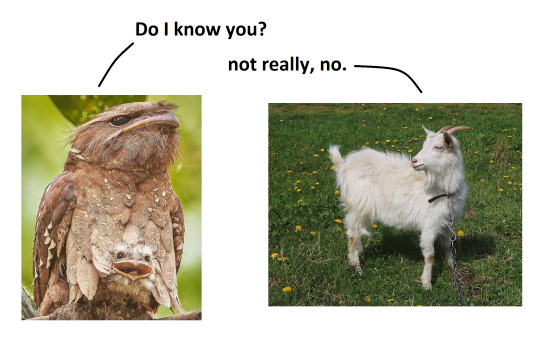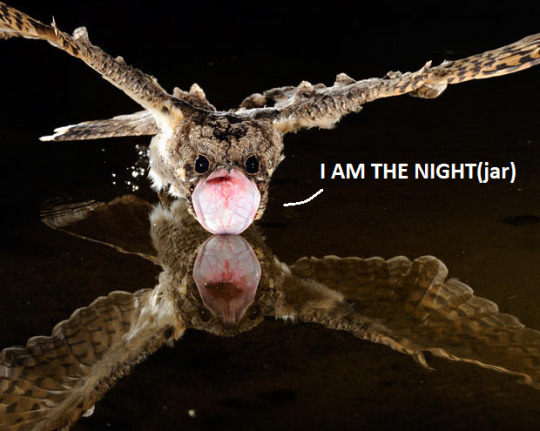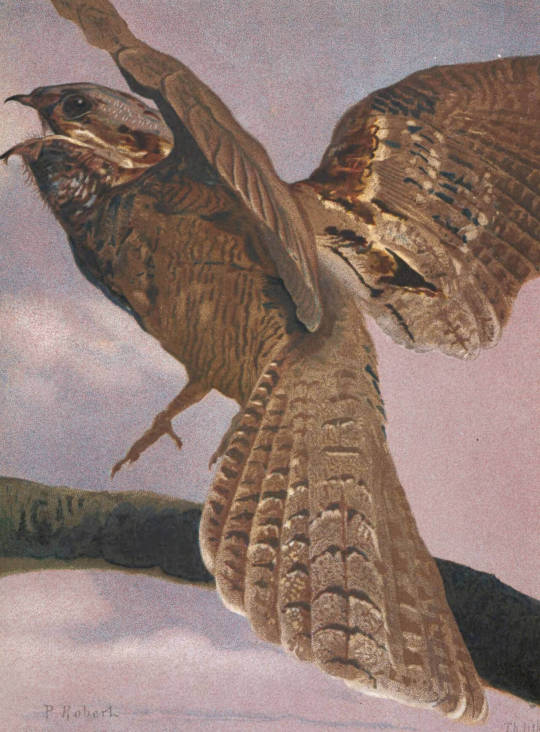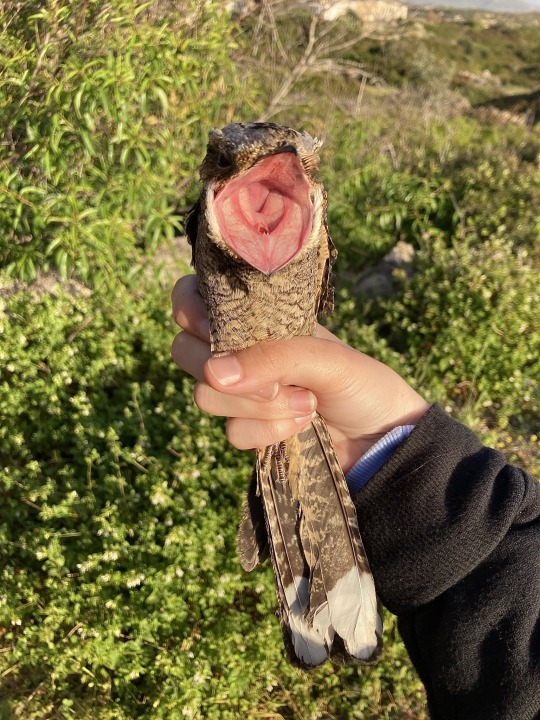#caprimulgus
Explore tagged Tumblr posts
Text

Large-tailed Nightjar (Caprimulgus macrurus), family Caprimulgidae, Puerto Princesa, Palawan, Philippines
photograph by Gid Ferrer
608 notes
·
View notes
Text

[2973/11080] Donaldson Smith's nightjar - Caprimulgus donaldsoni
Order: Caprimulgiformes (nightjars) Family: Caprimulgidae Subfamily: Caprimulginae (typical nightjars)
Photo credit: Raimund Barth via Macaulay Library
#birds#Donaldson Smith's nightjar#Caprimulgiformes#Caprimulgidae#Caprimulginae#Caprimulgus#birds a to z#undescribed#25% - 50%
151 notes
·
View notes
Text

毎日いじめられて眠れないヨタカ。
3 notes
·
View notes
Text
Fun related (?) fact:
My grandmother told me that the boogeyman equivalent they used to scare her and other kids from going in the woods was el latacàvare, literally "the goat milker". This in northern Italy in the 40's. I have no idea what this creature was supposed to look like or do, nor whether there was anything more beside just the name. I would really like to know if there's some folkloric theme connecting the bird, the chupacabra and this boogeyman, which I've never heard of anywhere else.
Fun Fact: The birds known as “Goat suckers”
So. This week is a little different, just for fun! We’re going to get into the etymology of a group of birds, with a little bit of folklore mixed in, because I think it’s neat!
Since you are on the internet, you may be familiar with Caprimulgiformes. Well. That name is A Lot, so you probably don’t know them by that name, but they are an Order of birds that includes such internet sensations as Frogmouths and Nightjars and Whip-poor-wills.
Another term for them is “Goat suckers”.

Why? Let me explain:
The Order name “Caprimuliformes” can be broken into two basic parts:
Capra: (latin) “goat” (yes, like capricorn).
mulgeō: (latin) “I milk”
Which, in turn, can be combined to create the word:
caprimulgus: (latin) “goat milker”. At some point, people started translating this as “goat sucker”, and I am not one to disagree, on account of it being a funnier name, in my correct opinion.
This is not to be confused with another so-called goat-sucker: el chupacabra (Spanish: chupar, ‘to suck’, and cabras, ‘goats’). I guess everyone is very worried about their goats getting– actually, nevermind.
Caprimulgiformes are aerial insectivores, meaning they capture insects out of the air. In many parts of the world, people have noticed that they like to hang out around goats (and other herd animals, but lets focus on the goats). Why? Well, the real reason is because bugs are attracted to the goats, and these birds are attracted to the bugs. These birds also happen to be nocturnal.

Now, if these birds caught bugs during the day, they would probably have a different name, and this would likely be the end of the story. However, the fact that they appear at night, swooping low over the goat herds for mysterious reasons, is something that goat herders in ancient Greece apparently found to be very untrustworthy.
You see, sometimes, nanny goats suddenly stop producing milk. This can happen for a variety of reasons, and these reasons are often not obvious. And when ancient goat herders discovered a goat suddenly wasn’t producing milk one morning, they, like all humans, want to know the reason.
So they thought to themselves: what could have happened since yesterday to cause this? What have I seen? What have I noticed?
And they remember those birds, which only appear at night, and swoop low over the heads of their goats for no discernible reason. And those goat herders thought to themselves: huh. Maybe they stole the milk.
at least, this is how I imagine the reasoning went
This was likely not helped by the goatsuckers’ mouths, which look like this:

I suspect ancient Greek goat herders thought that looked about right for stealing goat milk. Like. It’s around the right size to fit around a goat teat. They’re actually like that because they’re essentially ram-feeders, meaning they open their mouth and fly through a swarm of insects, trying to catch as many as they can. Bigger mouth = more bugs.
At any rate, we know that people thought this, because this guy you may have heard of, Pliny the elder, passed on this little pearl of wisdom in 77 CE (quote from a 1601 translation):
“The Caprimulgi (so called of milking goats) […] bee night-theeves; for all the day long they see not. Their manner is to come into the sheepeheards coats and goat-pens, and to the goats udders presently they goe, and suck the milke at their teats. And looke what udder is so milked, it giveth no more milke, but misliketh and falleth away afterwards, and the goats become blind withall.”
Dang. They also make goats go blind? Powerful little birds, I guess!
Nowadays, I’m not sure if anyone really believes this bit of folklore. Maybe it exists in small communities, but I don’t know of any. Even in 77 C.E., Pliny seemed a bit doubtful of this fact. In another bit of writing, where he recounts an old man telling him about the harms of goatsuckers, he ends the story with the line “But possibly that aged man was jesting with me.” (quote from Dictionary of American Bird Names).

(bonus:
In my area, we have the “whip-poor-will”, because their call sounds like they’re repeating “whip-poor-will” over and over and over and over and over and over and over. They also happen to be nocturnal, and love to call at around 2am right outside my tent. (I still love them but also oh my god let me rest). Here’s a recording of their call if you want a taste. )
1K notes
·
View notes
Text
Caprimulgus ritae King et al., 2024 (new species)

(A male individual of Caprimulgus ritae photographed by James Eaton, from King et al., 2024)
Meaning of name: ritae = for Rita Bobbin [friend of the study's lead author, Ben F. King]
Suggested common name: Timor nightjar
Age: Holocene (Meghalayan), extant
Where found: Primarily in lowland forests on the islands of Timor and Wetar
How much is known: At least four collected specimens (two males and two females) are held in museum collections. A fifth specimen, an immature individual, may also belong to this species, but this has not been verified by genetic analysis.
Notes: Caprimulgus is a genus of nightjars, a group of nocturnal, insect-eating birds. Nightjars typically spend the day camouflaged against the ground and use their wide mouths to capture flying insects at night.
C. ritae is closely related to the Mees's nightjar (C. meesi) from the islands of Flores and Sumba, and the large-tailed nightjar (C. macrurus), which is found across South Asia, Southeast Asia (though not Timor or Wetar), and northern Australia. In addition to being genetically distinct and geographically separated from its close relatives, C. ritae is smaller than them on average. It can also be distinguished by its vocalizations and details of plumage patterning, such as having darker brown feathers on the sides of its face.
Reference: King, B.F., G. Sangster, C.R. Trainor, M. Irestedt, D.M. Prawiradilaga, and P.G.P. Ericson. 2024. A new species of nightjar (Caprimulgus) from Timor and Wetar, Lesser Sunda Islands, Wallacea. Ibis advance online publication. doi: 10.1111/ibi.13340
91 notes
·
View notes
Text

Engoulevent (1880) | Léo-Paul Robert (1851-1923)
281 notes
·
View notes
Photo

A new variant has been added!
Sulawesi Nightjar (Caprimulgus celebensis) © Jefta Natanael
It hatches from black, bold, diabolical, distinctive, explosive, extensive, long, outer, prominent, and white eggs.
squawkoverflow - the ultimate bird collecting game 🥚 hatch ❤️ collect 🤝 connect
2 notes
·
View notes
Text
Standard winged nightjars are so cool but im sorry sir you are a dick joke IM SORRYYYYYY
3 notes
·
View notes
Text


[https://www.inaturalist.org/observations/112646473]
Eurasian Nightjar || Caprimulgus europaeus
Observed in Greece
Least Concern in location of observation
Bird banding is much more fun for the banders than for the birds lol
#ornithology#nightjar#birds#nature#wildlife#photography#air beast#who cooks for queue? who cooks for queue all?#100#500#1k
3K notes
·
View notes
Note
Oh, I'm a goofy goober, yeah
You're a goofy goober, yeah
We're all goofy goobers, yeah
Goofy, goofy, goober, goober, yeah!
I'm a goofy goober, yeah
You're a goofy goober, yeah
We're all goofy goobers, yeah
Goofy, goofy, goober, goober, YEAH!
String identified:
, ' a g g, a
' a g g, a
' a g g, a
G, g, g, g, a!
' a g g, a
' a g g, a
' a g g, a
G, g, g, g, A!
Closest match: Caprimulgus europaeus genome assembly, chromosome: 10 Common name: European nightjar

2K notes
·
View notes
Text


Large-tailed Nightjar (Caprimulgus macrurus), mother and chick, family Caprimulgidae, order Caprimulgiformes, Singapore
photograph by Cheong Khan Hoong
2K notes
·
View notes
Text


Eurasian Nightjar (Caprimulgus europaeus) x.
3K notes
·
View notes
Text

Swamp Nightjar (Caprimulgus natalensis)
Habitat & Distribution
Resides in swamps, wetlands, lagoons, rivers and near tropical and subtropical forests
Found throughout sub-Saharan Africa
Physical Description
Weight: 60-70 g (2.1-2.5 oz)
Wingspan: up to 58 cm (22.8 in)
Adults are dark brown, grey, or black with bright gold and white spots along the back and wings
The head is quite large compared to the body, but the beak is rather small
Behaviour
Feeds mainly on insects such as beetles, moths, and flies
Hunts at night, and roots on the ground during the day
Adults live in monogamous pairs
Swamp nightjars are predated upon by owls, hawks, foxes, and snakes
Key Advantages
The plumage of the swamp nightjar makes it well suited for camoflage
When approached by predators, individuals will fly upwards in an startling explosive burst
Photo by Rei Segali
213 notes
·
View notes
Text

Chirruping Nightjar/Kayumangi Nightjar(Caprimulgus griseatus)
Look at this creature
165 notes
·
View notes
Text

Jerdon's Nightjar (Caprimulgus atripennis)
Sighted at Goa, India
#birb#bird photography#birdblr#birdphotography#birdwatching#birblr#birds#bird pics#caprimulgiformes#carprimulgidae#nightjar#bird
38 notes
·
View notes